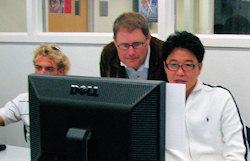Multimedia center a treasure trove for ELI students
There’s hidden treasure buried in the basement of Morris Library. And ELI teachers and students are wasting no time in mining it. More than any other university department, ELI is using the training and resources of the new Student Multimedia Design Center (SMDC).
“The English Language Institute is the biggest client, without question,” said Bryan Lane, multimedia design specialist. “Bookings for ELI classes outnumber all other departments two-to-one.”
The center, which opened on the lower level of the library in 2007, contains 70 workstations, six recording studios, two classrooms and a variety of video, photo and sound recording equipment.
 |
| ELI students, helped by specialist Bryan Lane (center), are taking advantage of the resources at the student Multimedia Design Center in the Morris Library |
One of the “gems” provided by the site is Lane himself, who was hired by the university two years ago to provide curricular liaison for the state-of-the-art facility.
“If a professor wants to integrate multimedia into a class,” Lane explained, “I teach them how and I train their students.”
Among the first ELI faculty to take him up on that were instructors Lisa Grimsley and Nonie Bell, who incorporated Photo Story into short-term teacher training programs during the summer of 2007. The software allowed the teachers to combine photos they had taken of different aspects of American culture with their own narration into a video they could share with colleagues and students upon their return to Korea.
Since then Bell and instructor Debbie Darrell have regularly scheduled their News classes into the center, with Lane providing weekly tutorials and consultation on using Photo Story to produce newscasts.
“It’s thrilling to go to your website and look at your newscasts. You realize this is going around the world,” Lane said.
Assistant Professor Barbara Morris has also jumped on the Photo Story bandwagon. Her Level III students used the software to integrate graphics with voice recordings of poems and prose.
“It’s a highly motivating and entertaining way for intermediate level learners to showcase the progress they’ve made,” she said. “It really brings home the importance of all we try to teach them––correct articulation, proper stress, rhythm and pausing. And the best part is, after one hour with Bryan, students can handle the software on their own.”
Julie Lopez enlists Lane’s support in training her English for Academic Purposes classes on effective PowerPoint presentations and Sarah Petersen has filmed skits produced by several of her classes, which she then edited using iMovie in the Center in order to share them on the widescreen at ELI graduation.
“Both the filming and editing were possible because I myself trained with Bryan in his special classes,” she said.
In addition to the ELI, other departments have used the resources at the SMDC. By far the “shining light” to date, said Lane, has been two documentaries on the aftermath of Hurricane Katrina and the 2004 Indian Ocean tsunami produced by students in sociology Professor Tricia Wachtendorf’s seminar on disaster, vulnerability and development. While eight-week classes at the ELI may never aspire to such long-term projects, it is clear that multimedia is a good fit for international speakers.
“Using pictures or other forms of media helps English learners get their meaning across,” said Lane. “It helps ease their fear of the language.” • BM